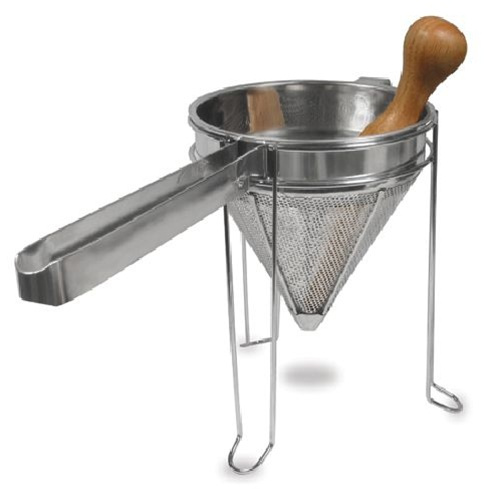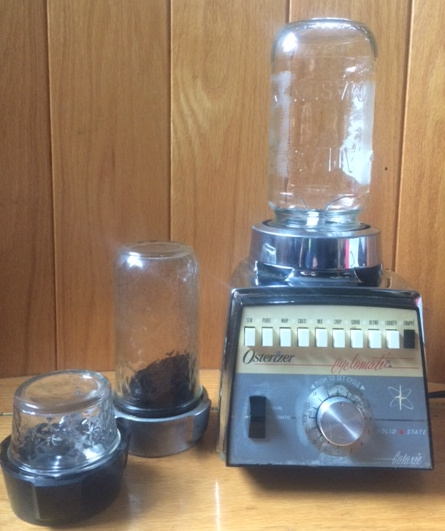Yeah, true dat. Might want a screen on the ass end to catch sticks.
Not a solution to my original question, but fits with the thread title…
Oster Blenders have the (unique?) feature of screwing into any size narrow mouthed mason jar. Which is really handy for grinding varying amounts of stuff with the same low cost tooling.
the one pictured is my coffee grinder at home. I paid $15 for it a St Vinnies. It came with the cast Alu base. I’ve got several more at work.
@Soxhlet cause it makes more sense here…
Waring actually makes itty bitty blenders for lab use, and I’ve used them in a number of settings…but I like my Osters better.
I spent almost 10 years working with a lab that studied chloroplast gene-expression, and their chloroplast prep SOP included a Waring with a set of 4 single edge razor blades instead of the stock blades. I believe it was made in the machine shop at the Max Planck, but it might have been a local copy of their design. The blades had to be swapped every couple of preps. In addition to my many other functions, I was one of two guys who were willing/allowed to swap the blades out…
The lab did explore other solutions, eg a Tekmar Tissumizer, which is pretty similar to the high shear homogenizers @CATScientific would like us all to have in out tool-kits. The blender of death did a better job.
That sounds like a bloody mess, quite literally.
not so much once I got involved. Simply required the right tooling/looking at the problem correctly. It did not require the chainmail glove they purchased after the 3rd injured postdoc ![]()
we are going to try out the futurolla. We need to be able to reduce a large amount quickly. so looked like it might work well enough. We’ll see.
The Futurolla works. It’s just not ideal. A flow through design would be more appropriate for extraction bound material if the grind could be kept uniform.
being able to set a run time, and then repeat that run with a single button push, rather than stepping up from zero seconds every time would also be an improvement. When you’re grinding 100lb, 2lb at a time, for 6 seconds, there are some 300 or so spurious button pushings required. (not certain that 2lb per is what my minions were actually loading… )
Fast moving (whirring) blades are not really ideal for producing a uniform particle size. The right weapon is a mill of some sort. probably a slow moving one with adjustable cutting surfaces.
That said, the Futurolla has found it’s way into many extraction labs, and is certainly a step up from the ninja.
Hammer mill if your going for production, you will want to sort your material before grinding, cause like the above said it will turn to dust by the end! We have grinded 500lbs in a 8 shift so not to bad.
@TheCatalyst I would argue that avoiding dust is a primary goal.
Ideally one wants a defined particle size range. Not too small, not too large. The ideal size range almost certainly depends on the solvent/process being used, with “ideal” varying somewhat within solvent/process type because of packing density chosen by the operator.
I agree that a mill is appropriate. I’m not sure a hammer style mill is the correct choice. I’d still love to know which one you’re using.
I absolutely agree that sorting out the trash first rather than grinding and extracting it is the correct response.
One might infer from your handle that you predominantly produce hydrocarbon extracts. Is that correct? 500lb of biomass seems like an insane throughput for butane extraction. Where you grinding a weeks worth of material up front?
check these out i used one at a co2 lab i worked at
http://www.meadowsmills.com/sbm8.html
http://www.meadowsmills.com/sbm12.html
Hydrocarbon for sure, it lasted about a week and a half, they do have different size grates you can put in, but their smallest isn’t really that small, might need some custom made. But like I said for mass production hydrocarbon extraction hammer mill has been wonderful so far
thanks. packed column extraction is different from agitated slurry as far as how problematic fines are. Although I know from experience that fines can slow down packed column hydrocarbon extractions too. The higher pressures associated with CO2 extraction presumably alleviate some of the problems with finely ground material.
I happen to have a PhD on the team who did a lot of work on particle size and resulting flow characteristics before and after her doctorate. So I’m probably looking at this harder than most.
8 days to process 500lbs is definitely up there, but doesn’t sound nearly as insane as blowing 500lb in a day.
Nice! Yeah like you said on bug runs it gets real thick and we have even had an issue or two with the run becoming clogged which isn’t fun, but like I said 99% of the time it works perfect.
Might look into conical screen mills, theoretically they should create much less dust then a hammer mill, less noise and more consistent sizes. (I’ve not used one but told about them)
AWESOME! That might just be the clue I was looking for.
they essentially mirror my gold standard…
product is forced through a conical screen with appropriately sized holes.
here is the simplest implementation, which makes the connection to my preferred method abundantly clear.

Has anyone used anything like either of these mills for high-volume grinding/milling?
This one is ~7k, claims 1100 lb/hr dry corn at 1/16"
https://pleasanthillgrain.com/hippo-hammer-mills-1-hippo-usa
This one is ~27k, claims ~300 lb/hr dry corn at 1/16"
http://www.kannamill.com/kannamill-food-grade/
Does anyone have experience using a Toro 51621 vac/ blower/ mulcher for grinding/ transferring biomass?
Yes. I work with a bosch brand
I have blunted the rotor theeth for iT to grind less
IT works fast yet creates a fair amount of dust
But after the milling process i pass My material treu a vacuum de seeder to get ris of the seeds that My material has
Something You Guy’s luckely don t have to
Yet i can tell You that a vacuum deseeder works really Well on size partition
The dust go s in the vacuum cleaner the leaves in the catch compartment
And the seeds and stems fall
straight true
By putting a fancontroler on the vacuum blower i can fairly precise adjust what i want to cathc
Thank you again @Roguelab!
The hemp guys here probably need to understand that trick!
I suspect using the digital power regulator that @SkyHighLer told us about would give you even better control…
Thank you @Roguelab.
Are you saying that you’re able to mulch everything (leaves, stems, seeds) together with the vac mulcher, and then WITHOUT having to go through manually to remove stems or seeds, you’re then able to use the seed cleaner to dial in your partitioning? I’m particularly interested in the idea that we wouldn’t need to slowly pick through our biomass to remove stems as you can tell ![]()
Thank you again.
